Chapter 12.9: China
Imperial China, an Introduction
Imperial Chinese history is marked by the rise and fall of many dynasties and occasional periods of disunity, but overall the age was remarkably stable and marked by a sophisticated governing system that included the concept of a meritocracy. Each dynasty had its own distinct characteristics and in many eras encounters with foreign cultural and political influences through territorial expansion and waves of immigration also brought new stimulus to China.
China had a highly literate society that greatly valued poetry and brush-written calligraphy, which, along with painting, were called the Three Perfections, reflecting the esteemed position of the arts in Chinese life. Imperial China produced many technological advancements that have enriched the world, including paper and porcelain.
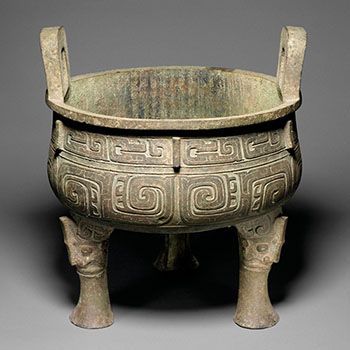
Video
Early Chinese Art: Jade Cong (5:11)
China Religious Teachings
Confucianism, Daoism and Buddhism Confucianism, Daoism and Buddhism were the dominant teachings of religions in Imperial China and most individuals combined all three in their daily lives.
Each of these teachings is represented by paintings in The British Museum, most notably by The Admonitions Scroll after Gu Kaizhi (image left) and the cache of Buddhist scroll paintings from the eighth to tenth century that had been rolled up and sealed away in the eleventh century in Cave 17 at Dunhuang’s Caves of the Thousand Buddhas.
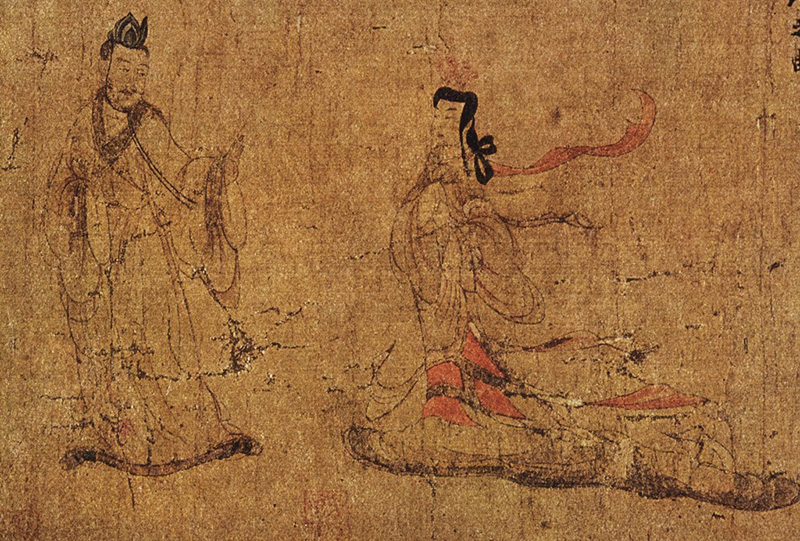
Videos
Buddhist Temples at Wutaishan (4:08)
Appreciating Chinese Calligraphy (4:03)
Oracle Bone, Shang Dynasty (3:46)
Da Ke King, Tripod Pot (5:36)
The First Emperor and the Terra Cotta Warriors
The First Emperor Qin Shihuang (259-210 B.C.E.) conquered much in this life, but his driving purpose was even greater; he sought to conquer death. In order to achieve immortality, he built himself a tomb—a vast underground city guarded by a life-size terracotta army including warriors, infantrymen, horses, chariots and all their attendant armor and weaponry.
The underground terracotta army found in the First Emperor’s burial complex is undoubtedly one of the most remarkable and mysterious discoveries from the ancient world. A sprawling citadel has been unearthed, complete with gardens and stables, bronze ritual vessels, jade jewelry, and a wealth of gold and silver ornaments.
Besides revealing much about an ancient way of life, observing the physical construction of the underground complex and the methodical production of the figures reveals a set of themes from which we gain a window of insight to the First Emperor’s worldview and enduring influence.

Innovation
The First Emperor is known for stunning innovations that consolidated his rule through modernization. During his reign, he introduced the standardization of currency, writing, measurements and more. He connected cities and states with advanced systems of roads and canals. He is also credited with continuing the construction of the Great Wall, which is perhaps the most widely-known symbol still associated with China to this day.
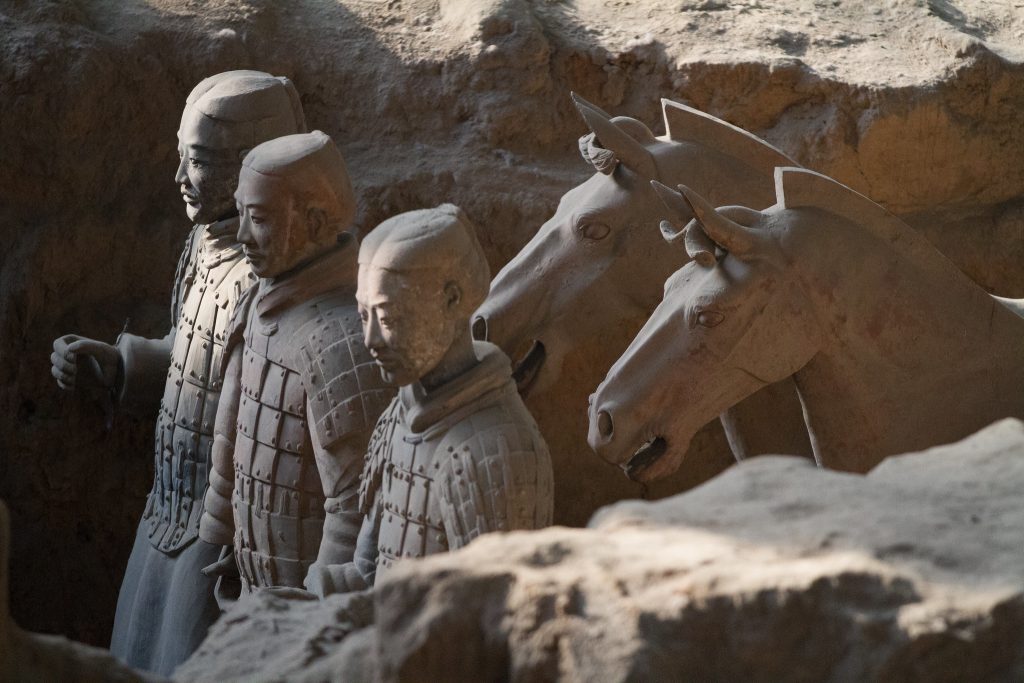
He is regarded as a military genius, and while his methods included massacre and destruction, some claim that his ultimate success at bringing the states together justifies the violence, a necessary cost of nation-building. We also see the first assembly-line style production in the creation of his terracotta warriors, horses and chariots.
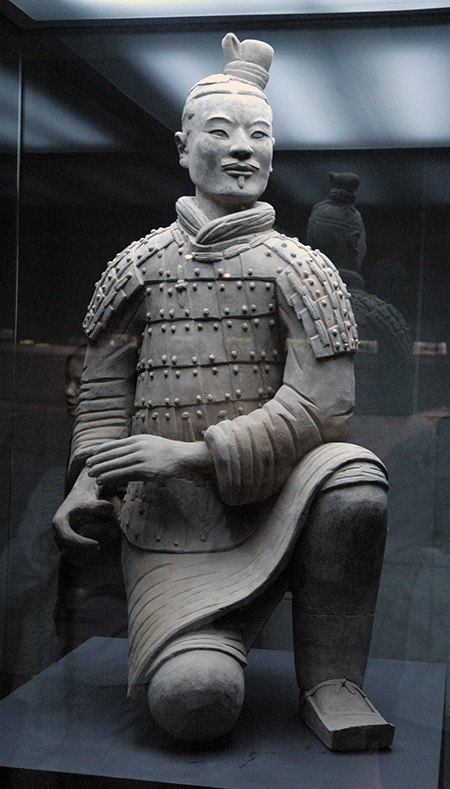
Immortality
Perhaps the most fascinating aspect of the burial complex is what it suggests about the young Emperor’s obsession with immortality. Driven to conquer death itself, the eventual First Emperor ascended to the throne of the Qin state at age of 13 and immediately began to plan his burial, and more importantly, his underground palace, a mausoleum attended by an army including over 7,000 terracotta warriors horses, chariots and weaponry intended to protect him in the afterlife.
The First Emperor envisioned a subterranean domain that would parallel his worldly existence after corporal death. According to Han-dynasty historian Sima Qian, the First Emperor lined his burial complex with a treasury of riches and piles of precious gemstones said to represent the stars, sun and moon. He was deeply concerned with the universe and looked to the cosmos as a guide for crossing over to an immortal existence. Excavation also revealed other mysterious findings, like strangely high levels of mercury and evidence that the poisonous substance coursed through an intricate system of underground troughs, replicating the topography of the actual rivers and seas carving the surrounding landscape. Some suggest that the emperor believed mercury had life-giving power and so surrounded himself with the toxic element, believing it was yet another way he might live forever.
Unification
Of all the accomplishments from this extraordinary period, the unification of China is, without question, the greatest symbol of the Qin dynasty’s power and influence. Born in a time of turmoil in China’s history, known as the Warring States period (475-221 B.C.E.), The First Emperor founded the short-lived Qin dynasty (221-206 B.C.E.). By 221 B.C.E., he merged the seven warring states into one nation and took the name Qin Shihuang, which means First Emperor. He left a legacy of a centralized and bureaucratic state that would be carried onto successive dynasties over the next two millennia.
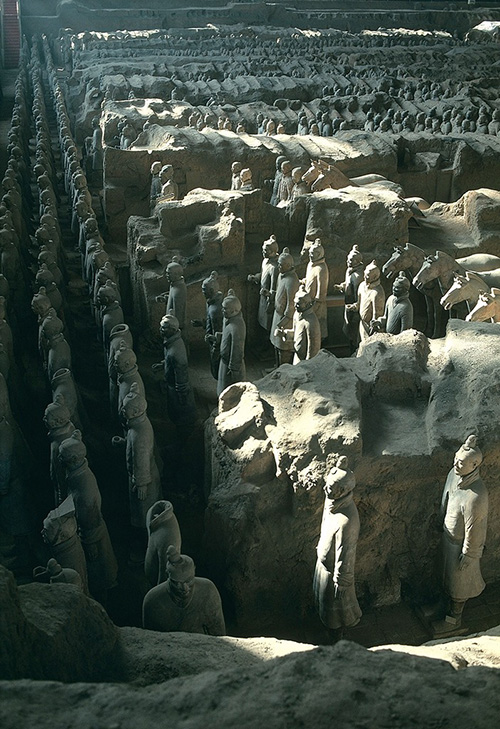
Prior to his taking the throne, the Qin state had been in existence for over half a century—under the single clan Ying though never under the rule of one individual. The rulers of the State of Qin had gradually expanded their domain over the centuries, but the slow effort culminated in ultimate victory when The First Emperor succeeded in uniting the once-divided empire.
Archaeology
When the burial complex was first discovered by farmers in 1974, archaeologists set to work on one of the most astonishing ancient sites on record. The excavation uncovered a sprawling citadel with thousands of warriors, each designed with a unique face and clothing. In addition to the warriors themselves, the dig uncovered horses, chariots, bronze ritual vessels, jade jewelry, and gold and silver ornaments. According to historian Sima Qian, the emperor so feared that his artisans “might disclose all the treasure that was in the tomb, . . [that] after the burial and sealing up of the treasures, the middle gate was shut and the outer gate closed to imprison all the artisans and laborers, so that no one came out.”
The story of the burial complex is also fascinating because it was conceived by such a very young individual. Court records reveal that, despite taking the throne at the age of 13 (in 246 B.C.E.), the eventual emperor ordered construction to begin almost immediately. Enormous numbers of laborers worked on the project, which was halted as the dynasty neared collapse. To date, four pits have been partially excavated. Three contain terracotta soldiers, horse-drawn chariots and weapons. The fourth pit was found empty, a testament to the original unfinished construction.
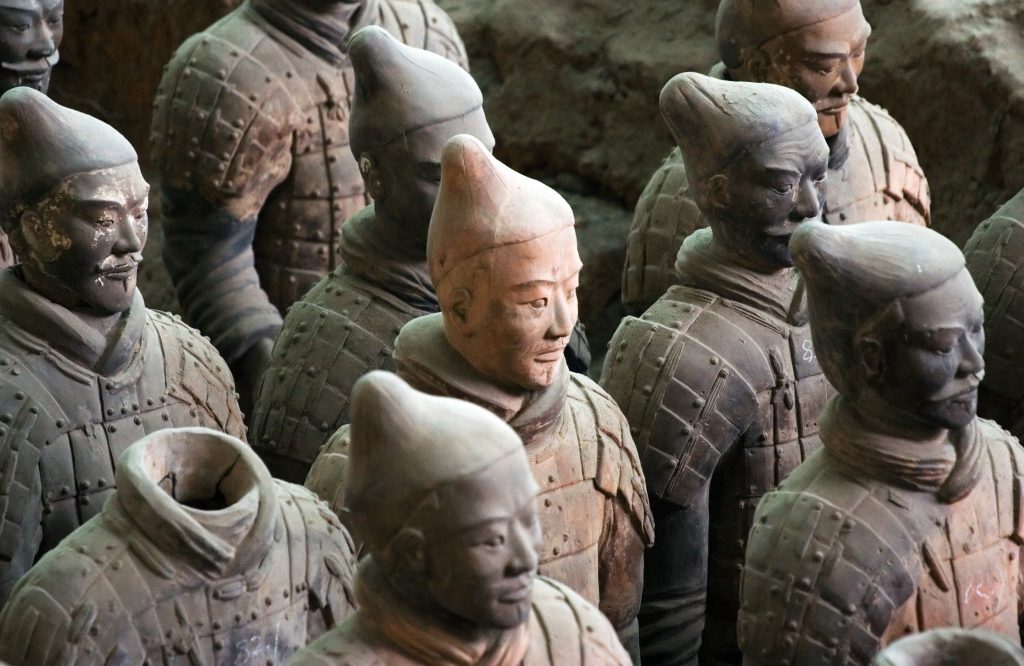
One of the most extraordinary features of the terracotta warriors is that each appears to have distinct features—an incredible feat of craftsmanship and production. Despite the custom construction of these figures, studies of their proportions reveal that their frames were created using an assembly production system that paved the way for advances in mass production and commerce.
Archaeologists estimate that the objects, including figures, horses, and weapons, number in the thousands, though the true total may never be known.
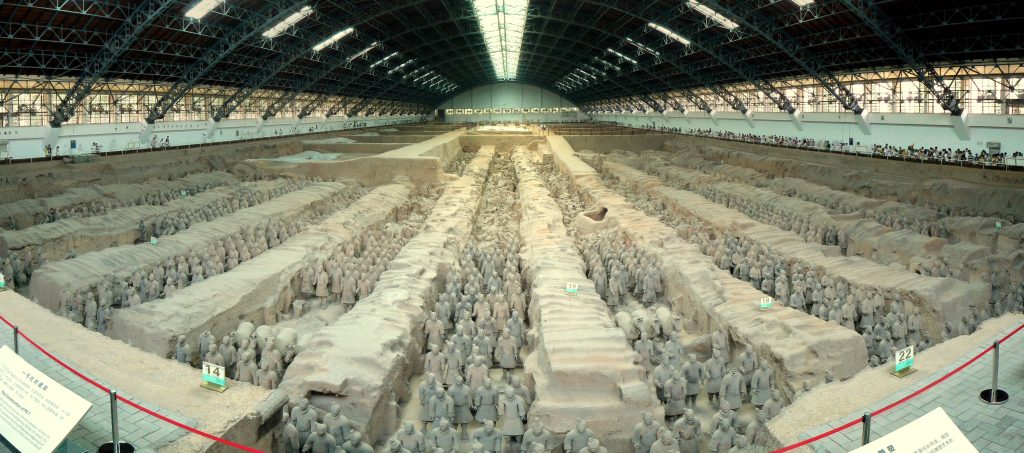
History of Chinese Porcelain
Porcelain traces its origins back to ancient China, emerging during the Tang dynasty (618–907) in a basic early form. It wasn’t until the Yuan dynasty (1279–1368) that the refined porcelain later recognized in Europe took shape. This is the variety that Marco Polo encountered and later introduced to Europe in the 14th century.
By the 16th century, with global trade routes more firmly established, Chinese porcelain began to be exported to Europe, where demand for this elegant material quickly grew.
Despite its popularity, European artisans struggled for centuries to replicate the technique. It wasn’t until the early 1700s that German alchemist Johann Friedrich Böttger discovered the correct method, leading to the creation of Europe’s first porcelain factory in Meissen. Around the same time in England, bone china emerged as a new type of porcelain. This variant incorporated calcined bone ash, giving it enhanced strength, translucency, and a creamy white color. While traditional hard porcelain is strong, it is prone to chipping and often carries a slight bluish or gray hue unless specially processed. Bone china, on the other hand, is both durable and aesthetically refined, making it easier to produce and more resilient against damage.
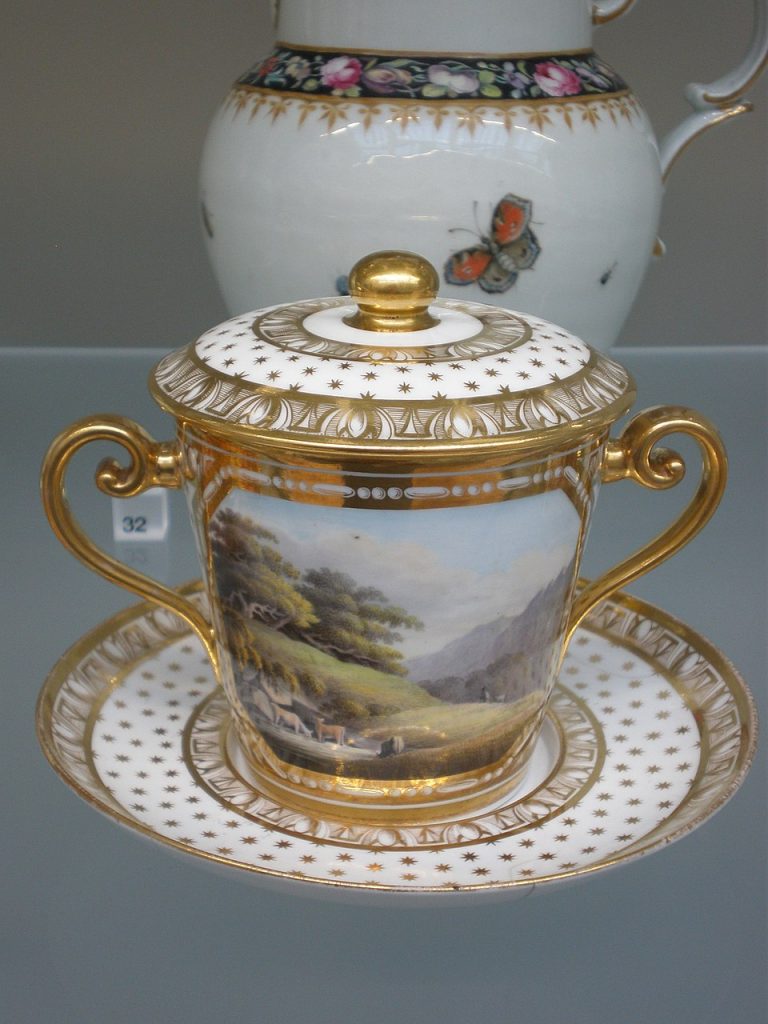
A Few Types of Chinese Porcelain
Chinese porcelain has evolved over centuries, with each era showcasing distinct styles and techniques. Below are three notable types that highlight the artistry and innovation of their respective periods:
- Tang Sancai (700–900 AD): This style, meaning “Tang Three Colors,” became popular during the Tang Dynasty. It featured a signature blend of three main colors—green, brown, and creamy white—and was commonly used for decoration and in tombs as funerary objects.
- White Porcelain (1000–1400 AD): Widely used during the Song Dynasty, this type of porcelain stood out for its smooth, bright surface that resembled jade. Its design focused on simplicity and elegance, making it a classic example of Chinese ceramic artistry.
- Blue and White Porcelain (1400–1700 AD): Though its roots trace back to the Tang and Song dynasties, this porcelain style truly flourished in the Yuan period. It features bold cobalt blue designs painted beneath a clear white glaze and is one of the most famous and widely recognized forms of Chinese porcelain.
Tang Dynasty Ceramics
The Tang Dynasty (618–907 CE) is well known for its lively and vividly painted tomb figures. These pieces—often shaped like horses, camels, and officials—were made from low-fired earthenware and created specifically for burial purposes. Although they are widely admired today, they were not considered cutting-edge in terms of ceramic craftsmanship at the time, nor were they especially valued by collectors.
Most of the lead-glazed Sancai (三彩), meaning “three-colored” ceramics, were produced by three kilns in northern China. These wares were commonly used to decorate the tombs of the upper class for over 150 years during the Tang period.
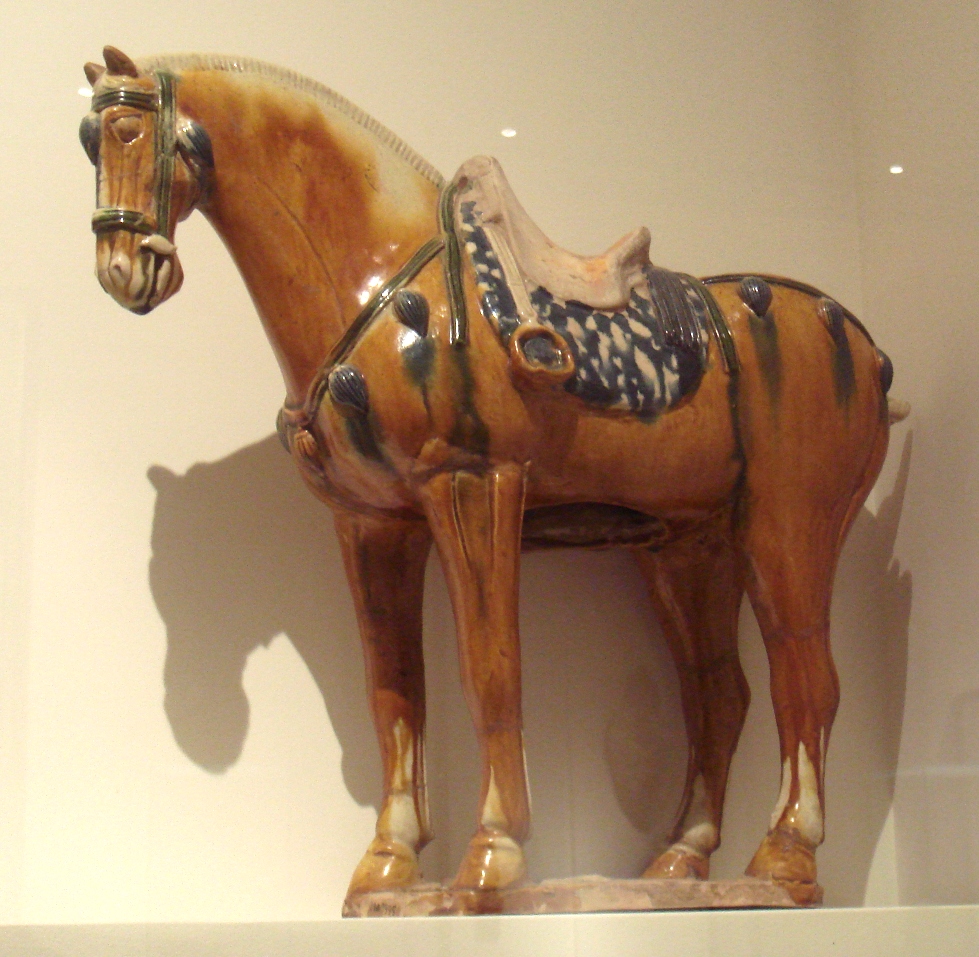
Optional Videos: Other works in Chinese art through the years
Masterpiece: Seated Buddha Dated 338 (2:03)
Longmen Grottoes (2:52)
Bodhisattva, Northern Qi Dynasty (550-577) (7:47)
Chinese Buddhist Cave Shrine, Tang Dynasty (618-907) (4:36)
Master of the (Fishing) Nets Garden, Song Dynasty (960-1279) (8:50)
Buddha of Medicine Bhaishajyaguru (Yaoshi fo), Yuan dynasty (1271-1368) (5:37)
The David Vases, Yuan dynasty (1271-1368) (4:47)
Congyi, Cloudy Mountains, Ming dynasty (1368–1644) | 82nd & Fifth: “Eternity” by Maxwell K. Hearn (2:17)
Media Attributions
- Figure 1. Tripod Food Container (Ding), Chinese; Western Zhou dynasty, 1050 B.C.-771 B.C. (Image source: © The Art Institute of Chicago via Artstor. Used with permission, for education use only)
- Figure 2. “The Admonitions of the Instructress to the Court Ladies,” The Admonitions Scroll. Attributed to Gu Kaizhi. Silk with ink and colours, 222-589 A.D. (Image source: UC San Diego via Artstor. Used with Permission, for education use only)
- Figure 3. Terracotta warriors from the mausoleum of the first Qin emperor of China Qin Shihuang, c. 221-206 B.C.E., Qin Dynasty, painted terracotta, Terracotta Warriors and Horses Museum, Shaanxi, China (Image source: Keith Marshall via Flickr) is licensed under a CC BY-NC-SA (Attribution NonCommercial ShareAlike) license
- Figure 4. Terracotta warriors from the mausoleum of the first Qin emperor of China Qin Shihuang, c. 221-206 B.C.E., Qin Dynasty, painted terracotta. The cavalry horses are approximately life-size. They have a saddle but stirrups were not in use at this time (Image source: The.Rohit, via Flickr) is licensed under a CC BY-NC (Attribution NonCommercial) license
- Figure 5. Terracotta warriors from the mausoleum of the first Qin emperor of China Qin Shihuang, c. 221-206 B.C.E., Qin Dynasty, painted terracotta, Terracotta Warriors and Horses Museum, Shaanxi, China (Image source: Naadir Jeewa, via Flickr) is licensed under a CC BY-NC-SA (Attribution NonCommercial ShareAlike) license
- Figure 6. Terracotta warriors from the mausoleum of the first Qin emperor of China Qin Shihuang, c. 221-206 B.C.E., Qin Dynasty, painted terracotta (Image source: © Hiroji Kubota / Magnum Photos via Artstor. Used with permission, for education use only)
- Figure 7. Armored infantryman, Terracotta warriors from the mausoleum of the first Qin emperor of China Qin Shihuang, c. 221-206 B.C.E., Qin Dynasty, painted terracotta, Terracotta Warriors and Horses Museum, Shaanxi, China. Armored infantryman wear body and shoulder armor. Their hands are positioned to hold a lance (left hand) and a crossbow (right hand). They wear their hair in a topknot covered by a soft cap that ties at the back (Image source: Romain Guy via Khan Academy) is licensed under a CC BY-NC-SA (Attribution NonCommercial ShareAlike) license
- Figure 8. Terracotta warriors from the mausoleum of the first Qin emperor of China Qin Shihuang, c. 221-206 B.C.E., Qin Dynasty, painted terracotta, Terracotta Warriors and Horses Museum, Shaanxi, China (Image source: Will Clayton via Flickr) is licensed under a CC BY (Attribution) license
- Figure 9. Staffordshire bone china covered chocolate cabinet cup, with enamels and gilding, ca. 1815–20, Victoria and Albert Museum (Image source: Wikimedia Commons) is licensed under a CC BY-SA (Attribution ShareAlike) license
- Figure 10. Tang dynasty tomb figure, Sancai horse, 7–8th century (Image source: Wikimedia Commons) is licensed under a CC BY-SA (Attribution ShareAlike) license
Candela Citations
- Imperial China, an introduction. Authored by: The British Museum. Provided by: Khan Academy. Retrieved from: https://www.khanacademy.org/humanities/art-asia/imperial-china/beginners-guide-imperial-china/a/imperial-china-an-introduction. License: CC BY-NC-SA: Attribution-NonCommercial-ShareAlike
- Jade Cong. Authored by: The British Museum. Provided by: Smarthistory. Retrieved from: https://smarthistory.org/jade-cong-2/. License: CC BY-NC-SA: Attribution-NonCommercial-ShareAlike
- Terracotta Warriors from the mausoleum of the first Qin emperor of China. Authored by: Asian Art Museum. Provided by: Khan Academy. Retrieved from: https://www.khanacademy.org/humanities/ap-art-history/south-east-se-asia/china-art/a/terracotta-warriors-from-the-mausoleum-of-the-first-qin-emperor-of-china. License: CC BY-NC-SA: Attribution-NonCommercial-ShareAlike
- What Is Porcelain, and Why Has It Been Cherished For Centuries?. Authored by: Carrie Whitney, Ph.D.. Retrieved from: https://home.howstuffworks.com/home-decor/decorating-styles-techniques/porcelain.htm. License: All Rights Reserved

